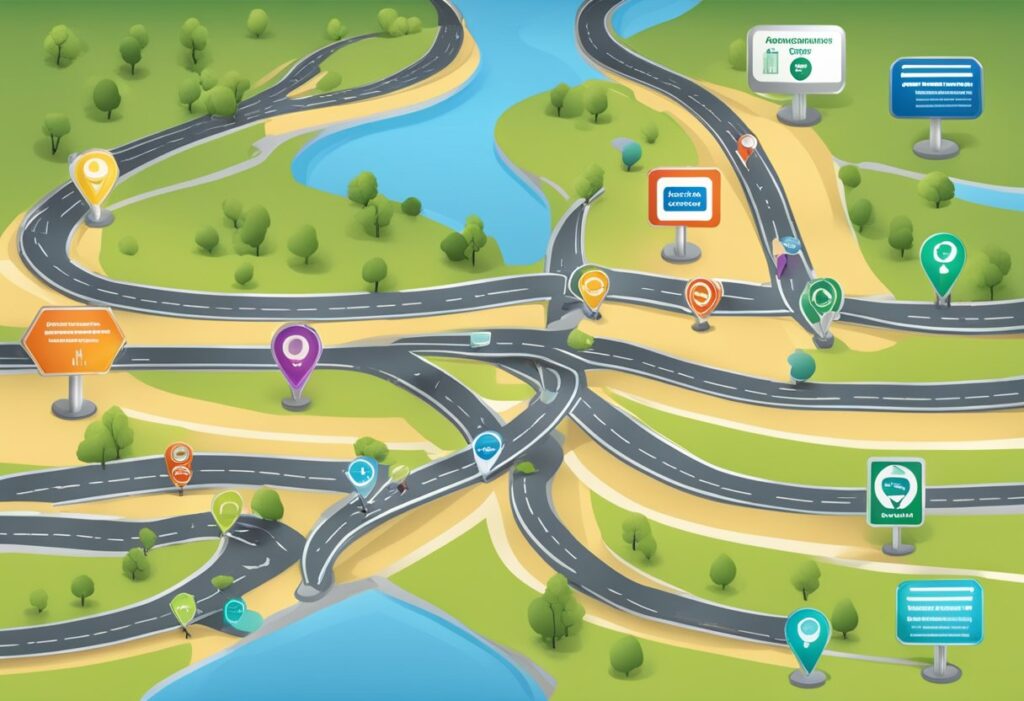In the current competitive business environment, possessing a **smart and enduring go-to-market strategy** is akin to having a treasure map for successfully launching new products or services and maintaining their success. This comprehensive plan assists businesses in capturing customer interest and shining like stars. It covers every essential aspect, from understanding market trends to product launch. Beginning with thorough market research ensures that the right audience is targeted and their needs and challenges are well understood. Dive in, and you’ll discover how to navigate these waters, ensuring that your product makes an impact and remains successful in the bustling market. Seize the opportunity to master the craft of an effective go-to-market strategy that ensures not only a significant initial impact but also a lasting impression.

The next crucial step is defining the value proposition and messaging, which should communicate the unique benefits and differentiators of the offering. This clarity in value proposition, combined with strategic product positioning and pricing, sets the stage for a resonant product launch. Aligning marketing and sales efforts to the customer journey then becomes pivotal, ensuring a unified front across all customer touchpoints. This integrated approach aims to not only make a powerful market entry but also to maintain momentum through focused marketing and promotional strategies.
Measurement and optimization must be ongoing, using performance data to refine tactics and strategies continually. This iterative process helps maintain the relevance and effectiveness of the go-to-market approach, addressing market shifts and consumer behavior changes in real time.
Key Takeaways
- A durable go-to-market strategy requires comprehensive market research and a clear value proposition.
- Strategic alignment across marketing, sales, and product offerings is essential for a cohesive customer experience.
- Continuous measurement and optimization are crucial for maintaining the effectiveness of go-to-market efforts.
Understanding Go-to-Market Strategy Fundamentals
Before we dive into the specifics, it’s essential to understand the core of a go-to-market (GTM) strategy. It is the blueprint we set to deliver our product or service to the customer. This encompasses the who, what, when, and how of delivering value through meaningful interactions.
Defining Go-to-Market Strategy
A go-to-market strategy is our systematic plan for reaching and converting prospects into customers. We design this strategy focused on delivering our product or service to the market efficiently and effectively. The goal is to maximize market penetration and revenue by aligning all aspects of our business—marketing, sales, and customer service—around the value we’re offering to our target audience.
Components of a GTM Strategy
The components of our GTM strategy function as the gears that drive our business forward. This includes:
- Market Definition: We must identify and understand our target market. Who are our ideal customers?
- Value Proposition: Clearly articulating the value we offer is crucial. What problem are we solving or need are we fulfilling?
- Sales and Marketing Tactics: We must decide on the mix of marketing and sales activities that will help us reach our audience. Which channels will we use to communicate with our customers?
- Delivery Model: How will we deliver our product or service? This could range from in-store to online platforms.
- Revenue Model: What’s our strategy for monetization? We need to ensure alignment of customer value with our revenue streams.
- The Team: Mapping out our internal team structure is vital. Do we have the right mix of skills and resources?
- Metrics and Monitoring: Establishing a framework for measuring success will guide us in optimizing our GTM strategy. What key performance indicators will we track?
Market Research and Analysis
In building a durable go-to-market strategy, we must thoroughly understand the competitive landscape and the specific needs of our target audience. This foundation will inform our strategic decisions and guide the development of a resilient and effective market approach.
Competitive Landscape and SWOT Analysis
To gauge where we stand in the market, we begin with a competitive analysis. This involves identifying key players, assessing their strengths and weaknesses, and benchmarking their strategies against ours.
- Strengths: We list our product’s unique features and how they outperform competitors.
- Weaknesses: We note any areas where competitors may have an edge.
- Opportunities: We look for market gaps or unmet customer needs that we can address.
- Threats: We keep an eye on emerging competitors and industry shifts that could impact our position.
By doing so, we develop a comprehensive SWOT Analysis that simplifies complex market dynamics into actionable insights.
Identifying Target Audience and Market Needs
Understanding our target audience is critical. We pinpoint our ideal customers based on demographics, psychographics, and behavior patterns. Here’s how we break it down:
- Demographics: Age, gender, income, education
- Psychographics: Values, attitudes, interests
- Behavioral: Purchasing habits, brand interactions, product usage
Once we’ve outlined who our customers are, we scrutinize their needs. This is where market research comes into play. Surveys, focus groups, and data analysis provide us with a clear picture of what our audience is looking for, allowing us to tailor our strategy to serve them better. With solid research and a deep understanding of market requirements, we position ourselves to meet demand effectively and sustainably.
Crafting Your Value Proposition and Messaging
In the realm of market strategy, we understand that a unique value proposition and aligned messaging are pivotal. They define how we’ll stand out and resonate with our target audience, shaping the success of our go-to-market strategy.
Establishing Unique Value Proposition
When we establish our value proposition, we’re defining the promise of value to be delivered. It’s crucial that ours is clear and unique; it should convey why we are the better choice. We begin by identifying our product’s features and tie them directly to the customer’s gains. For example, if our software improves productivity, we don’t just list “productivity enhancement” as a benefit. We quantify it, perhaps stating, “Our software saves you 10 hours a week, freeing you up to focus on growing your business.”
Aligning Messaging With Customer Pain Points
Our messaging must be crafted to align with our buyer persona’s most pressing pain points. It should not just spotlight features but address specific challenges and elucidate how our solution alleviates them. For instance, if customers are overwhelmed by complex project management, our messaging might be, “Simplify project complexity with our intuitive one-click management features.” We then back this up with real-world testimonials or case studies demonstrating this relief in action.
By adhering to these focal points, our value proposition and messaging will cut through the noise and strike a chord where it matters most.
Product Positioning and Pricing Strategy
When we examine the market strategy, it’s vital to understand that product positioning and pricing are two fundamental aspects that work synergistically to define a product’s place in the marketplace and its perceived value to customers. We’ll explore the intricacies of effective positioning and how to set an optimal price.
Developing Effective Product Positioning
Effective product positioning hinges on identifying and communicating the unique value our product offers. By analyzing the competitive landscape, we can establish a value matrix that distinguishes our product’s features, benefits, and the values that resonate with our target audience. It’s essential to clearly articulate the “Unique Selling Proposition” (USP) of our product to ensure it stands out in the minds of consumers.
- Determine how our product differs from competitors
- Articulate the USP to target the right segment
To position our product effectively, we must align it with the customer’s needs and desires. This involves tailoring our messaging to highlight the most compelling aspects of our product as they relate to these needs.
Setting the Right Pricing
Pricing is not simply a matter of determining cost-plus margins—it’s a strategic tool that must reflect the positioning of the product. A pricing strategy should be developed in accordance with the product’s value proposition and the competitive dynamics of the market. When we set the price, we look at several factors:
- Assess costs: Understand all costs involved to avoid losses.
- Understand value: Price according to the perceived value in the customer’s mind.
- Competitive analysis: Consider competitors’ pricing and how our product compares.
The ultimate goal with pricing is to strike a balance where the price underpins the product’s positioning, communicates its value, and meets the company’s financial objectives. In doing so, we ensure the price is an integral part of a cohesive go-to-market strategy.
Planning and Executing the Launch
As we gear up for launching a new product, our priority lies in meticulous planning and synchronized execution. We understand that a well-crafted plan and the unity of our cross-functional team are the cornerstones of a successful launch.
Creating a Detailed Launch Roadmap
Our launch roadmap is the blueprint for bringing our new product to market. We define clear objectives, assign tasks, and set firm deadlines to ensure nothing falls through the cracks. Here’s how we break it down:
- Objectives: Clearly define what we want to achieve with the launch, aligning with our overall market strategy.
- Tasks: List specific actions required to meet our objectives, from product development to marketing initiatives.
- Deadlines: Allocate realistic timelines for each task, creating a sense of urgency and pacing the rollout effectively.
Aligning the roadmap with the market’s needs ensures that our new product will resonate with potential customers upon release.
Coordinating Cross-functional Team Efforts
Our success hinges on the seamless collaboration of our cross-functional team. Each member plays a crucial role, and coordinating their efforts is imperative:
- Communication: Holding regular meetings to ensure everyone is on the same page and aware of any updates.
- Responsibility: Assign clear roles and responsibilities, so each team member knows what is expected of them.
- Monitoring Progress: Tracking each task against our deadlines to catch any delays early and adjust our plan accordingly.
By fostering a cooperative environment, we ensure that each aspect of the launch, from development to marketing, moves forward in harmony.
Marketing and Promotional Strategies

In building a go-to market strategy, the careful selection of marketing channels and a robust content marketing plan are essential. We focus on how to identify the most effective channels and craft advertising content that resonates with our target audience.
Exploring Marketing Channels and Distribution
When considering marketing channels, it’s crucial to evaluate where our audience spends their time and how they prefer to receive information. We analyze data points such as user demographics, engagement rates, and conversion statistics to identify platforms that promise the highest ROI. For instance, if our target demographic is highly active on social media, prioritizing platforms like Facebook or Instagram for our promotion strategies makes sense.
We also assess distribution channels that can provide the most seamless and efficient delivery of our product to the customer. Whether it’s direct online sales, partnering with retailers, or utilizing distributors, each channel’s costs and benefits are weighed to enhance our market penetration while maintaining a balance between reach and profitability.
Implementing Content Marketing and Advertising
Content marketing is another pillar of our strategy. It’s not just about creating content; it’s about creating the right content. We invest in developing informative blog posts, engaging videos, and captivating graphics that provide value to our audience. This content is designed to attract, engage, and retain customers by creating a narrative that aligns with their interests and needs.
Advertising is where we turn up the volume on our messaging. Through targeted ad campaigns, we enhance visibility and drive action. It’s about saying the right thing at the right time through the right medium. Paid search, display ads, and social media promotion are carefully crafted. Our advertisements are tailored to the platform they appear on, ensuring they capture attention and encourage interaction.
In all our efforts, the marketing strategy is fine-tuned to the objectives of each campaign, the nuances of our product, and the unique aspects of our target market. Utilizing a combination of organic reach via content marketing and amplified messaging through advertising, we aim to deliver a consistent and compelling message across all chosen channels and distribution channels.
Sales Alignment and Customer Journey

Ensuring that our sales and marketing efforts are synchronized and that we truly understand the customer’s journey are critical for the success of a go-to-market strategy. By aligning these functions, we optimize our buyer engagement and enhance our ability to close deals effectively.
Integrating Sales and Marketing Efforts
We recognize the importance of bridging the gap between our sales and marketing teams. Sales and marketing alignment is achieved through clear communication, shared goals, and mutual understanding of our target buyer personas. We prioritize unified messaging across all channels and touchpoints. By co-developing content and campaigns, our sales team can leverage marketing insight during the sales process, enabling them to engage leads with information that resonates and drives action.
- Shared Objectives: Set common targets for sales and marketing that reflect both lead quality and quantity.
- Regular Feedback Loop: Implement meetings for ongoing communication between sales and marketing to refine strategies.
- Coordinated Messaging: Ensure continuity of messaging from marketing content to sales conversations.
- Buyer Personas: Continuously update and distribute buyer personas to keep both teams informed on our target customers.
Mapping the Customer Journey
We map the customer journey meticulously to understand the various touchpoints our customers encounter. This map is a visual representation that guides our strategy for interacting with customers at each stage of their buying process, catering to their unique needs and concerns. By analyzing the journey, we can also identify potential bottlenecks and optimize the inbound strategy to facilitate a smoother sales process.
- Awareness: Utilize inbound tactics to capture attention and begin the journey.
- Consideration: Provide valuable content and solutions to position ourselves as the best choice.
- Decision: Equip our sales team with insights to tailor their approach to the customer’s specific situation and preferences.
- Touchpoint Identification: List all possible customer interactions, both online and offline.
- Pain Point Analysis: Highlight and address common challenges customers face along their journey.
- Personalized Engagement: Tailor interactions based on the customer’s stage in their journey.
Through meticulous alignment between our sales team and the insights garnered from the customer journey, we ensure a seamless and effective approach to market entry. Our strategies are predicated on a robust understanding of our clientele and a collaborative effort that aligns our sales and marketing activities.
Measurement and Optimization
When we look at crafting a durable go-to-market strategy, it’s essential for us to track specific metrics for measuring success and continuously optimize our approach. This ensures our strategies align with growth goals and performance expectations.
Tracking Key Performance Indicators
Key Performance Indicators (KPIs) are the backbone of any measurement strategy. We identify KPIs to monitor our progress, such as conversion rates (CRO), customer acquisition costs, and customer lifetime value. For instance, an optimized conversion rate directly correlates with increased growth. We leverage tools and platforms that provide real-time data, allowing us to make informed decisions promptly.
- Conversion Rate: The percentage of visitors who take a desired action.
- Customer Acquisition Cost: The total cost associated with acquiring a new customer.
- Customer Lifetime Value: The total worth of a customer to a company over the entirety of their relationship.
By tracking these KPIs, we can pinpoint areas of success and those necessitating improvement.
Adjusting Strategies for Growth
We know that a static strategy won’t suffice in a dynamic market. To foster sustainable growth, we must adjust our strategies based on the insights drawn from our performance metrics. This involves A/B testing different approaches to optimizing our sales funnel and revising our marketing tactics to better reach target audiences. Through iterative testing and data analysis, we refine our go-to-market strategy to maximize efficiency and effectiveness.
- A/B Testing: Comparing two versions of a webpage or app to see which one performs better.
- Sales Funnel Optimization: Improving each stage of the funnel to increase the overall conversion rate.
Through continuous adjustments and a data-driven mindset, we can ensure that our go-to-market strategies are not only durable but also primed for growth.





